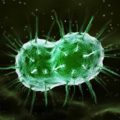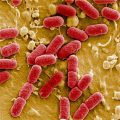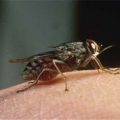Streptoderma children - a skin disease, manifested purulent inflammation, are caused by streptococci. The disease develops, When bacteria enter the damaged, with reduced protective functions, skin. Because of reduced immunity streptoderma most common in children.
Ways of infection
Streptococci are conditionally pathogenic microorganisms. It means, that a sufficiently strong immunity, contact with them is safe for human. Lowered immunity can be either local, and overall.
The development of disease is always associated with impaired skin integrity, while even enough microtrauma.
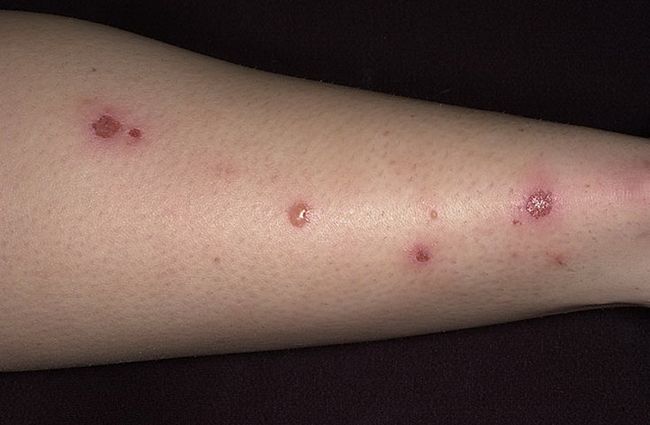
factors, which increase the likelihood of disease:
- Failure to comply with the rules of personal hygiene;
- overwrought (acute and chronic);
- nerve strain, stresses;
- hyponutrition, vitamins and essential substances deficit.
Streptococci can be found on the dishes, toys, clothes and get into the child's body through contact-household. Also on the child's skin, they can be caught through contact with insects, legs on which can carry Streptococcus.
Also notes the seasonality of the disease - in the winter the number of patients is largely increased, which is associated with an increase in cases of sore throat and scarlet fever - the cause is, that everyone considered a disease pathogen.
When there are such complex diseases, pathogens behave more aggressively, since already multiply, and it becomes much more difficult to cope with them.
Very rarely contamination can occur by droplets - if sneezing or coughing get ill from bacteria directly to the wound.
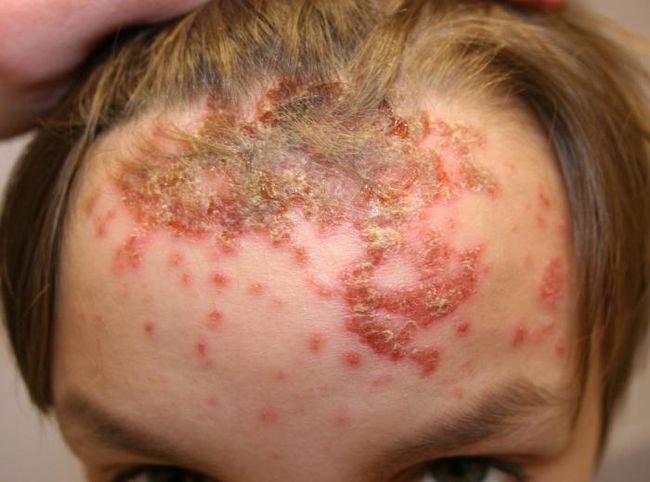
symptomatology
There are the classic symptoms and specific symptoms, which sets a specialist form of the disease.
General symptoms include:
- Body temperature rise above 38 degrees;
- Symptoms of intoxication;
- Headaches;
- Pain in joints and muscles;
- Nausea and vomiting;
- Lymphatitis;
- Abnormalities in blood test.
Changes on the skin manifest themselves as follows::
- The occurrence of small bubbles on the skin, inside which fluid collects (first transparent, then it becomes turbid);
- itch;
- The emergence of pigmentation in areas, wherein the disease manifests itself before.
Streptoderma in children manifests itself in about a week after infection. That's how long is the incubation period, after which there are skin rashes. These lesions appear as flat bubbles, surrounded by reddened skin.
Depending on the localization of lesions and the severity of the following forms streptoderma:
- Stryeptokokkovoye impyetigo. This is - the most common form of streptococcal. Characterized by the emergence of small-sized rash on the body open areas: face, hands, legs.
This streptoderma starts with a little red, which appears phlyctenas (bubbles on the surface). Clouding fluid opening is accompanied by spontaneous bubble, which dries and becomes crusty pale yellow. Once formed a crust will fall off, pink spots remain in its place, which will eventually disappear. Phlyctenas development time is about a week.
Since the disease is easy to handle, if you start to take action in the event of the first eruption. However, since the original streptoderma looks harmless, treatment, usually, late. And without the measures taken in time there is deterioration: child combing itchy skin; bacteria from the infected portion may remain on the cushion, toys, towel, and then get on the healthy skin. Because of this, there are more and more new areas of inflammation, which merge with each other, forming an impressive size spots. If not carried out proper treatment streptococcal children, the disease can be delayed for 3-4 of the week, and also increases the likelihood of developing complications. It is therefore important to know the, as the disease begins.
- bullous impetigo. This form of the disease refers to the more complex. Usually, site localization is the skin of the hands and feet, but lesions may also occur in other areas of the skin. Emerging bubbles is larger than phlyctenas, and the inflammatory process is expressed more clearly. Bullae appear on the background of the general symptoms, above. Inside the bubbles accumulate seropurulent liquid, and open erosion remains at the place of opening.
- slit impetigo. Streptoderma on the child's face is often in the corners of the lips, a little less - around the eyes and on the wings of the nose. In the beginning, there is one phlyctenas, which, usually, It does not cause much discomfort and treated quickly. Sometimes, however, the disease may progress to a chronic form. Here, a major role is played by factors such: lack of vitamins, malnutrition, dental disease, violation of rules of personal hygiene.
- Erityemato skvamoznaya stryeptodyermiya. It is a dry form of streptococcal, at which no bubbles are formed with a liquid, and dry pink spots, which formed white flakes. Dry streptoderma children develop rather slowly, but it is contagious, so avoid contact infected child with healthy children.
Diagnostics
For diagnosis it is necessary to consult a dermatologist.
Important! self-heal, streptoderma diagnosed the children of photos, it does not follow, because it can be confused with other diseases: urticaria, atopicheskim dermatitom and t.d.
However, a specialist immediately able to determine the cause of the rash, and say, how to cure the infection. If there are difficulties in the diagnosis of, can be carried out more research: sowing the microflora with the definition of sensitivity to antibiotics, blood test (general and biochemical), Urine and stool analysis.
Treatment
Any of the forms of the disease requires mandatory treatment. First of all, streptoderma spreads, affecting healthy skin. Secondly, on addictive. Thirdly, this disease is a severe blow to immunity and can provoke a large number of complications: glomerulonephritis, endocarditis, etc..
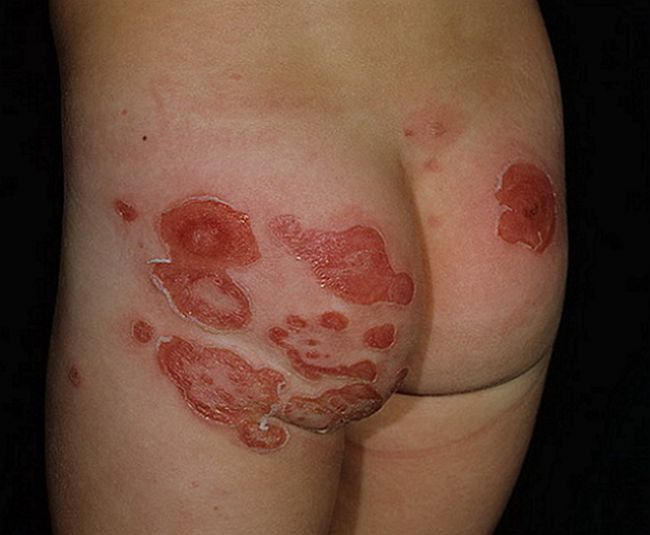
Treatment is carried out at home and at the exact performance of expert advice, streptoderma can cure within a week. It is imperative to comply with hygiene rules, as the use of drugs is not enough to heal.
rules, to be followed:
- You can not defeat watering place, best avoided water treatment for 3-4 days, as they are in this case may cause enhanced infection;
- Healthy skin is recommended to wipe several times a day with a solution of chamomile;
- It is important to monitor, the child is not combed affected areas. You can use antihistamines, who will advise the doctor;
- Towel the baby should have its own, and no one else should use it, to avoid infection;
- For the period of the disease should avoid soft toys, leaving plastic, that need to be cleaned regularly;
- If in addition to the inflamed areas of skin have more minor injuries, they should be treated with antiseptic.
Today, there are plenty of pharmaceutical agents, that help fight infection.
Of antiseptics should be used:
- Hydrogen peroxide 1%;
- Zelenka;
- Fukorcin;
- Salitsilovыy alcohol 2%.
The drug is applied several times a day to the affected area with a small seizure around the house. At the time of application of these means will be unpleasant sensations: child may complain, he strongly burns. Discomfort passes within a few minutes, then you can use the ointment.
It is not always possible to do in the treatment of streptococcal without antibiotic. Antibiotics for streptococcal children applied topically and orally. In some cases, hormonal creams can be assigned, but they should be used only a short period of time. Prolonged use they can backfire: reduce the protective functions of the skin.
Treat the child can streptoderma, using the following antibiotic ointment:
- erythromycin ointment;
- tetracycline ointment;
- Baneocin;
- mupirocin;
- Retamapulin;
- chloramphenicol;
- Levomicetin;
- gentamicin ointment.
hormonal ointment:
- Lorinden;
- triderm;
- Betaderm.
If we consider antibiotics for oral, the most common treatment of penicillin antibiotics:
- amoxicillin;
- Amoksiklav;
- Flemoksyn Soljutab;
- Augmentin.
cephalosporin series:
- ciprofloxacin;
- Tsyfuroksym;
- Supraks.
macrolides:
- clarithromycin;
- erythromycin;
- clindamycin;
- Sumamed.
Famous doctor Komarovsky, talking about, how to treat streptococcal impetigo in children, also talks about, Antibiotics do an excellent job with strep, so their use is the optimal treatment for streptococcal infection. He stresses the need to disinfect the area, surrounding the affected area, iodine. Know his view that, than cure streptoderma, It can be in the video.
Preventive actions
Infect the child, be sure to insulate. Also, the 10-day quarantine is imposed on children, with which contacted the baby. Very often there are outbreaks in kindergartens, because children communicate with each other, not always complied with the rules of hygiene, like soft toys.
Prevention in addition to avoid contact with the sick child includes measures to strengthen the immune system, vitamin therapy, personal hygiene, hardening and nutrition.



